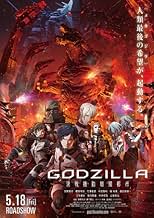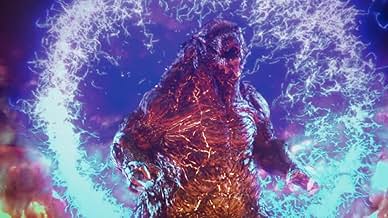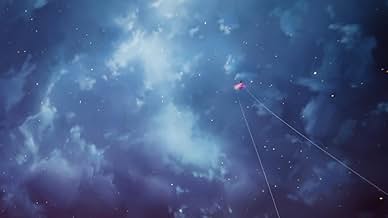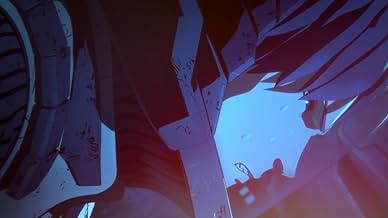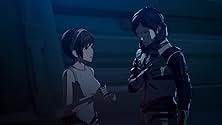Godzilla: Ciudad al filo de la batalla
En la Tierra, Haruo y sus acompañantes entablan contacto con la tribu indígena Houtua. Para vencer a Godzilla, ponen rumbo a las viejas instalaciones de Mechagodzilla.En la Tierra, Haruo y sus acompañantes entablan contacto con la tribu indígena Houtua. Para vencer a Godzilla, ponen rumbo a las viejas instalaciones de Mechagodzilla.En la Tierra, Haruo y sus acompañantes entablan contacto con la tribu indígena Houtua. Para vencer a Godzilla, ponen rumbo a las viejas instalaciones de Mechagodzilla.
- Dirección
- Guión
- Reparto principal
- Endurph
- (voz)
- …
- Maina
- (voz)
Reseñas destacadas
While the first film had lots of set-up time and had both a dull color scheme and a static cast, here the drama is more engaging and a greater variety of color is used. Characters have greater emotional range and are a bit fleshed out more, especially protagonist Haruo who is just starting to undergo a change beyond his "We must kill Godzilla" mentality that frankly made him stale first time around. More world-building is brought in and it's pretty interesting, particularly the Houtua culture and the further look into the aliens' views and backstories. There's also a conflict that happens between the characters that shifts the dynamic of their campaign, which I found engaging. There are fascinating themes at play with elements of evolution, religion, individualism, nature vs technology, and what truly separates man from monster. As for Godzilla, whenever he's on-screen, he is still both powerful and intimidating, not to mention pulls a couple of unexpected moves.
Sadly, weighty flaws hurt Part 2. First off, the film repeats the same basic story beats of Part 1 down to a similar climax. Like before, Godzilla doesn't come around until the climax, so waiting is in order. There's also misleading marketing in that Mechagodzilla, despite all the advertising, plays no active role; in fact, he's barely seen (the prequel novels seem to have more going on in them). This is due to the low budget and strict limitations Toho gave the staff. Characters tend to repeat things over and over and most (Haruo aside) don't change much from their starting roles and personalities. Moreover, there's a romantic subplot that I felt could've been done better.
"Godzilla: City on the Edge of Battle" is something of an improvement over the past entry. The new stuff is mostly good, the action is entertaining enough, and there's more going on thematically and drama-wise, but the film's reluctance to go further and instead repeat what was done before, coupled with the absence of substantial side character progression, held it back. The after-credit scene promises the arrival of a classic Godzilla foe, putting pressure in the final entry of this trilogy to really deliver, which I hope it does.
If you are old-school Godzilla fan you expect to see 'Godzilla vs MechaGodzilla' in the movie you will be disappointed. If you are Anime fan and Godzilla fan wanted to see something new this is for you.
GODZILLA CITY ON THE EDGE OF BATTLE is a more traditional "Moby Dick" story of how dedication to their mission slowly but surely turns the protagonists into something worse than the creature they are hunting. The callback is rather blatant, right down to the survivors wanting to use a sort of "harpoon" to take down Godzilla (it makes sense in context).
Like captain Ahab of the classic tale, we are presented with the fine line between dedication and obsession. When does one become another? Does one truly have to become a monster to kill a monster? How far will someone go to uphold their dedication to a fleeting ideal? In typical anime style, this theme is fleshed out in both a symbolic and literal level, with parallel thematic developments for our protagonist Haruo, Yuko, and humanity's allies from the stars, the Bilusaludo.
With all these great elements, the anime only suffers if the audience does not accept it's often deconstructive execution of the plot. Expectations are cleverly subverted, underlying themes switch between literal and symbolic, even the monsters are referred to in both an actual and a figurative sense. This might come across as a little confusing for those who do not take the time to think through the story and read between the lines.
Visuals-wise, GODZILLA: CITY ON THE EDGE OF BATTLE retains the cel shaded CGI look of the first film and many of Polygon Studio's work. The animation, which beautifully mimics that of traditional 2D animation right down to the reduced frame rate, is really an acquired taste that may not be for everyone. It is calling back to something old, using something new. Small improvements have been made particularly in the drab mono coloured creatures that populate far future earth. Godzilla himself gets a harsher shading and contrast in lighting which makes him distinct from the already dull grey background.
These little improvements make me hopeful for the upcoming finale to this trilogy. It is not perfect and the improvements may come too slowly for more cynical viewers. Like the animation style, the movies so far are truly an acquired taste that boils down to personal preference. Complex or confusing? Subverting expectations or failing to deliver on its publicity? Perhaps the greater battle is not within Haruo himself, or between monsters, or even between the various factions and Godzilla. Perhaps it is between the fans.
¿Sabías que...?
- CuriosidadesThis film features Godzilla Earth, the largest incarnation of the character to date, which was previously seen at the end of Godzilla: El planeta de los monstruos (2017). Godzilla Earth is 300 meters tall and weighs 100,000 metric tons, with the second-largest version of Godzilla, featured in Shin Godzilla (2016), standing 118.5 meters tall and weighing 92,000 metric tons.
- PifiasThe characters reason that the Hotua tribe must stem from the human race since they closely resemble humans. This logic is undermined by the fact that in this universe, both the Bilusaludo and the Exif aliens also look just like humans apart from a few very minor differences. The Hotua don't look any more human than they do.
- Citas
Halu-Elu Dolu-Do: Don't you want to win against Godzilla? With limited time and limited resources, it's an obvious decision to begin discarding the most inefficient thing. The physical body is one such thing, right?
Haruo Sakaki: Metphies mentioned that you guys wanted to become the same being as monsters. Are you planning to give birth to a new Godzilla on this planet?
Halu-Elu Dolu-Do: Godzilla is the product of Earth's civilization. You seem to regret this as a mistake, but for me, I commend it as a great achievement. If you were to be faulted, it's the foolishness that you couldn't control Godzilla that was generously born. Think about who this planet currently belongs to. If Godzilla was the name given to the environment's ruler, we humanoids must attain the goal of becoming Godzilla.
Haruo Sakaki: Are you being serious?
Rilu-Elu Belu-Be: To be fused with Mechagodzilla City is the same as organisms evolving to the next stage. Instead of being weak creatures controlled by emotions, you'll live in a world of perfect logic.
- Créditos adicionalesA scene which sets up the next installment follows the final credits.
- ConexionesFeatured in What Will I Watch? (Netflix Browsing) (2018)
Selecciones populares
- How long is Godzilla: City on the Edge of Battle?Con tecnología de Alexa
Detalles
- Fecha de lanzamiento
- País de origen
- Sitio oficial
- Idioma
- Títulos en diferentes países
- Godzilla: City on the Edge of Battle
- Empresas productoras
- Ver más compañías en los créditos en IMDbPro
- Duración1 hora 41 minutos
- Color
- Relación de aspecto
- 1.78 : 1
Contribuir a esta página


